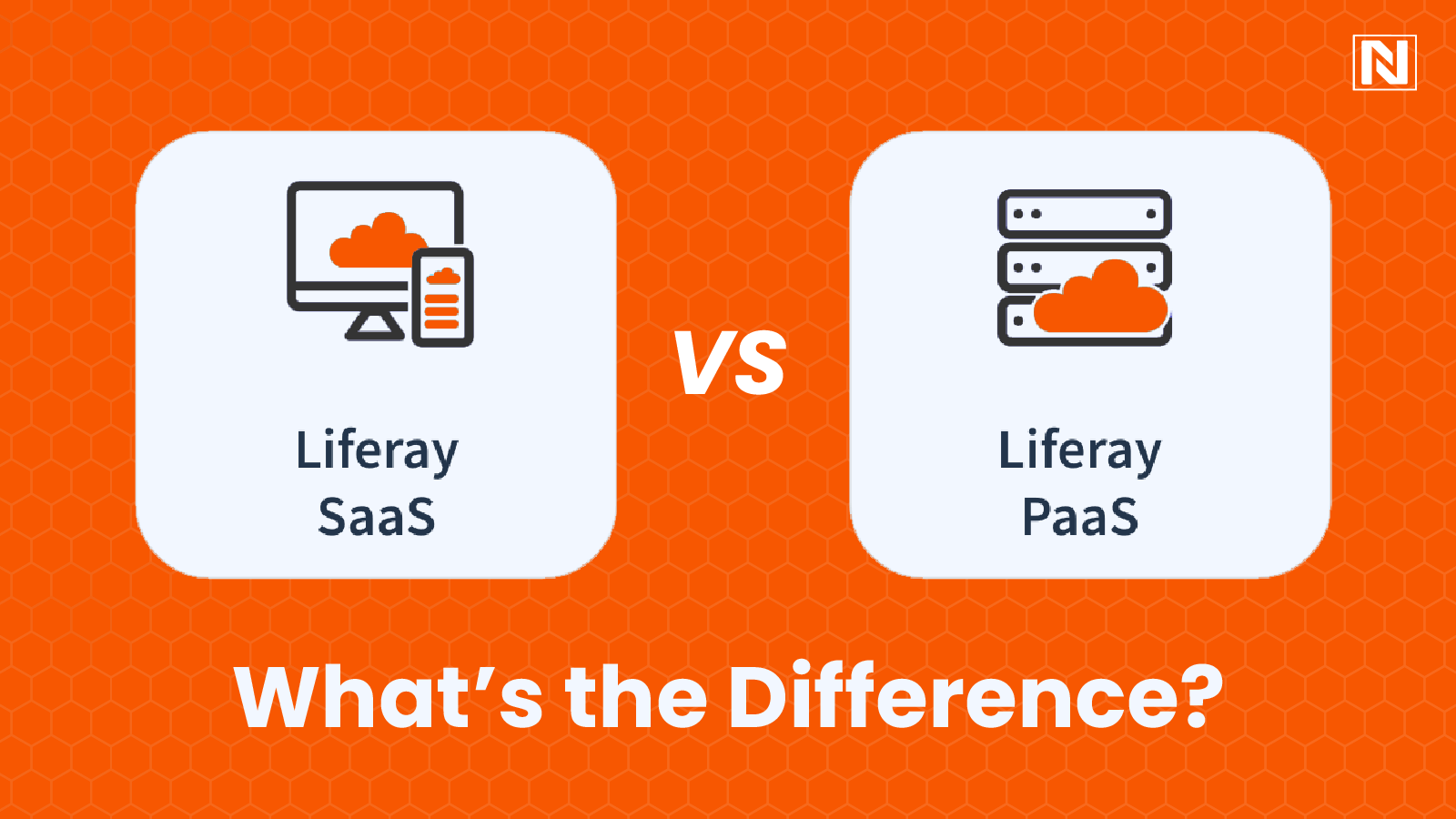
Choosing the right deployment model for Liferay can make or break your digital experience. But with PaaS vs SaaS offering different advantages, how do you decide which one aligns with your business goals? Is it about control, scalability, or ease of use? Before you make a critical choice, let’s break down the key differences. Is scalability more critical than control? Before you commit to a path that could shape your digital future, let’s dissect the real differences and reveal which option truly fits your needs.
PaaS vs SaaS Difference
PaaS and SaaS are two key models of cloud computing alongside IaaS that are delivered by third-party providers.
But what exactly do Platform as a Service (PaaS) and Software as a Service (SaaS) mean?
In simple terms, “as-a-service” cloud solutions let businesses shift the burden of managing IT infrastructure to expert providers. These vendors handle everything from security and uptime to scalability and performance. Unlike traditional on-premise setups, these services are accessible anytime, anywhere, just an internet connection and a browser or app is all you need.
So, what should you expect from PaaS and SaaS? Let’s explore.
What is a PaaS Solution?
Platform as a Service (PaaS) empowers businesses and developers to build, host, and deploy consumer-facing applications with ease. With PaaS, the underlying hardware and software are managed by the provider, who delivers a fully integrated development and deployment environment. This eliminates the need for maintaining on-premise infrastructure, allowing teams to get started from day one.
While the platform takes care of core infrastructure ensuring security, uptime, and storage, businesses retain control over their applications and data. This balance offers the flexibility developers need for customization, along with the robust foundation required for operational reliability.
Beyond immediate deployment capabilities, PaaS brings several valuable advantages, including:
- Enhanced Flexibility and Scalability
- Cost-Efficient
- User-Friendly
- Tailored Applications
- No Software Maintenance
PaaS (Platform as a Service) solutions are favored by businesses and developers for their ability to abstract the complexities of cloud infrastructure, enabling a strong focus on innovation and customization.
Popular PaaS platforms include:
- Google App Engine
- OpenShift
- Liferay Experience Cloud Self-Managed (SM)
What is a SaaS Solution?
Software as a Service (SaaS) is a fully managed cloud computing solution that delivers complete applications over the internet, typically accessed via a web browser. With SaaS, the provider takes care of everything from updates and bug fixes to routine maintenance, eliminating the need for customers to install or manage any software locally. Users can simply log in through a dashboard or integrate via an API.
Thanks to its scalability and user-friendly setup, SaaS offers several key benefits to organizations, including:
- Say goodbye to managing, updating, or upgrading your SaaS application.
- SaaS apps won’t consume your local computing power.
- Cloud-based solutions enable quicker time-to-market.
- SaaS products are typically more user-friendly and accessible.
These benefits make the SaaS product model one of the most preferred cloud service models for businesses today.
Popular SaaS solutions include Slack, Hubspot, and Liferay Experience Cloud.
DID YOU KNOW?
The forecast indicates that the global cloud computing market is projected to expand significantly, from USD 626.4 Billion in 2023 to USD 1,266.4 Billion by 2028, with a compound annual growth rate (CAGR) of 15.1%.
What is an IaaS Solution?
IaaS, or Infrastructure as a Service, provides vendors with the same technologies and capabilities as traditional data centers, but with a key difference: customers are in charge of managing their own applications, runtime, middleware, and data. Essentially, IaaS requires customers to build their own tech stack, which makes it more akin to managing on-premise systems in practice.
By offering only the servers and APIs, an IaaS provider gives you more control over your solution. This approach allows you to scale and manage your data as your business grows, without the need for physical infrastructure. Along with the increased control, the IaaS cloud service model also enables you to:
- Leverage an external server with zero maintenance requirements.
- Pay only for the resources you actually use, on a pay-as-you-go basis.
- Easily scale your services up or down as per your needs.
Popular IaaS solutions include Amazon Web Services, Google Cloud, and Microsoft Azure.
Should You Use SaaS or PaaS?
SaaS, PaaS, and on-premise solutions aren’t necessarily alternatives to one another, many businesses utilize a combination of them. The right choice depends on the specific functionalities your organization needs.
Refer to this chart to compare the features, control, and benefits each option offers, helping you decide which one aligns best with your business requirements:
| Aspect | On-Premise | PaaS | SaaS |
| Cost | Involves expenses for hardware, dedicated staff, rent, air conditioning, energy, and security. | Users pay a subscription fee based on the resources used for a project. | Users pay a monthly or annual fee, typically on a per-user basis, to access the software. |
| Development | Developers need to set up environments and procure a technology stack from scratch. | PaaS provides a complete tech stack, including hardware and software, for app development, testing, and deployment. | SaaS offers limited customization, with some providing only out-of-the-box functionality and others allowing more flexibility. |
| Control | Offers the greatest control over applications, as the server is on-premise. | Developers can build and run their own solutions, but the data is hosted on third-party servers, limiting total control. | The third-party vendor manages the application, reducing control over the software. |
| Data Security | Provides direct access to data, but businesses must manage data security and compliance themselves. | PaaS providers implement security and compliance, offering features like “Bring Your Own Key” for encryption, though risks remain. | SaaS vendors handle security and compliance; however, risks like unauthorized access and data theft still exist. |
| Performance & Uptime | IT and development teams manage performance, including applications, servers, networking, and storage. | Development teams are responsible for app performance, while the vendor maintains the underlying platform’s performance. | The SaaS vendor manages application performance and uptime, relieving the user from this responsibility. |
| Integration | Developers can create custom integrations, though poor design can affect performance and reliability. | Customizations may be necessary for legacy systems, requiring a significant investment. | Integration with legacy systems can be challenging, depending on whether the SaaS follows open standards. |
| Capacity Elasticity | Scaling is complex and costly, requiring additional software and hardware. | Scaling is managed by the vendor, with minimal effort required on the user’s part, though some tuning might be needed. | Scaling is fully transparent to end users, and all configuration and resource allocation are handled by the vendor. |
How to Choose the Right PaaS or SaaS Provider
PaaS and SaaS services are transforming the way organizations function. With the rapid expansion of cloud computing, the market for these solutions is growing exponentially. While this offers more choices than ever, it can also lead to decision overload, especially when every provider asserts they’re the best.

So, how can you make the right choice for your business, whether you’re considering a SaaS or PaaS provider? Here are three essential factors to consider:
- Compliance: When evaluating a cloud service provider, it’s essential to verify their commitment to industry standards, best practices, and regulatory requirements. Look for certifications such as ISO 27001 or HIPAA compliance to ensure they meet the necessary benchmarks.
- Reliability: Reliability is a fundamental yet critical factor for any PaaS or SaaS provider. The vendor should have robust disaster recovery plans and strategies in place, ensuring service availability during both scheduled maintenance and unexpected downtime.
- Data Security: While PaaS and SaaS solutions offer the convenience of hosting your data on third-party servers, this also means security largely falls outside your control. It’s important to validate the provider’s security certifications and review their track record for any past data breaches. Ensure they have the right protection measures, processes, and policies in place to safeguard your data.
Conclusion
No matter the solution, the future lies in the cloud. Forward-thinking business leaders know that the most effective way to scale and expand their business is by leveraging cloud-based solutions. Contact us to see how you can reach new heights in the cloud world.
